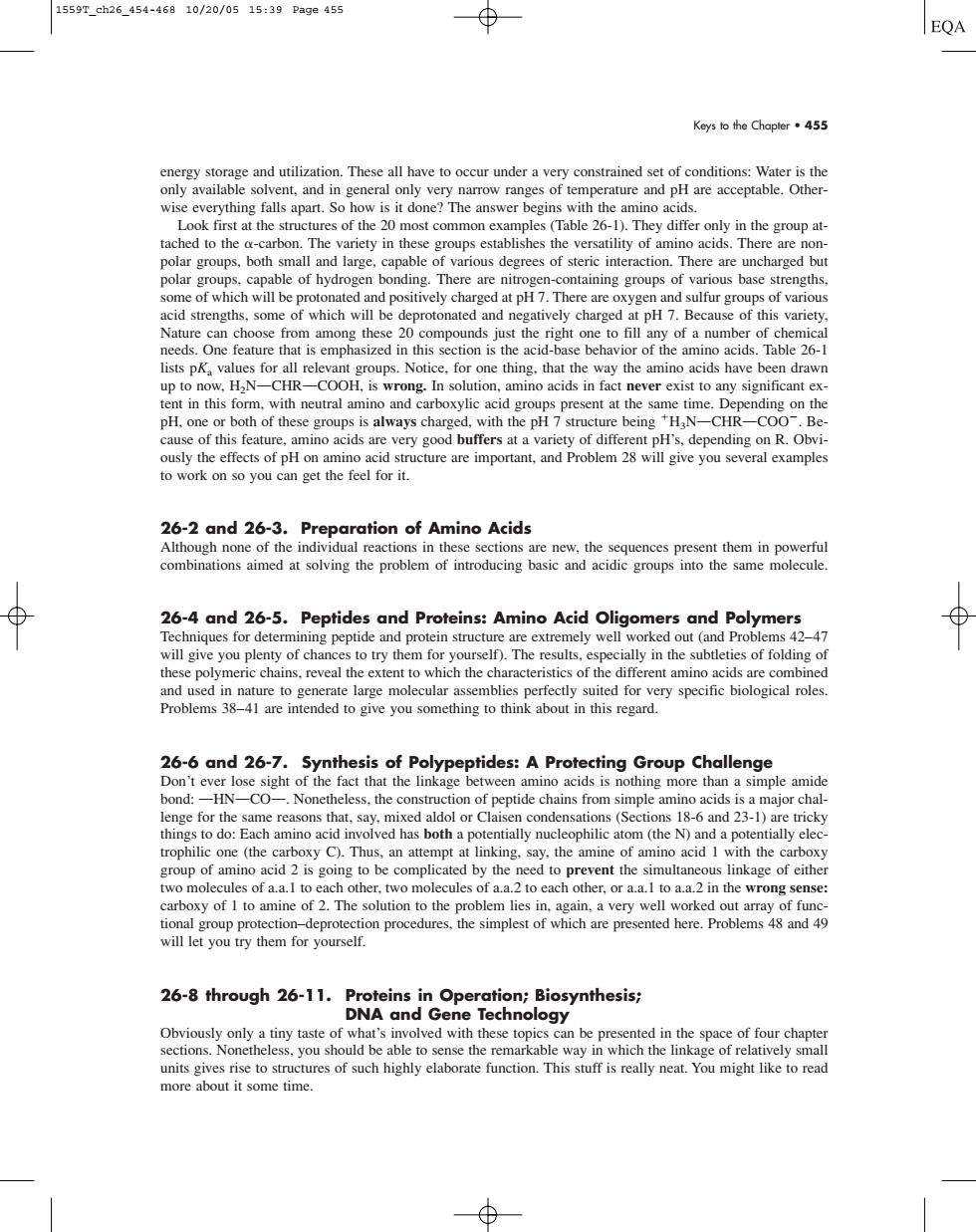正在加载图片...

1559T_ch26_454-46810/20/0515:39Pa9e455 EQA Keys to the Chapter·455 R onstrained set of conditions:Water is the y very narrow ranges of temperature and pH are acceptable.Other The answer begn only in the polar groups.both small and large. capable of various egrees of There are uncharged bu polar hic will be eof this varicty. ofbe depoontod and negaivly chargodp lists pk valu s for all rele oups.Notice.for one thing.that the way the amino acids have been drawn up to no wrong.In so amino acids in fact never exi to pH.one or both of theseg oups is always charged.with the pH 7structure COOBe. gteeiectsofpHon ation of Amine acids 一2i子and子6r3eP时thrntinowr combinations aimed at solving the problem of introducing basic and acidic groups into the same molecule. 26-4 and 26-5.Peptides and Proteins:Amino Acid Oligomers and Polymers determining peptide and pro extremely well of fo 26-6an 26 Synth esis of Polypeptides:A Protecting Group Challenge ptide chains from condensations(Sections 18-6 and 23-1) e trick y nu y el at linkine two mol les of a.a.I to ther.two mo oh a.a to each er,or a.a. o a.a. in the wrong se tional gr will let you try them for yourself. 26-8 through 26-11.Proteins in Operation;Biosynthesis; DNA and Gene Technology units gives rise to structures of such highly elaborate function.This stuff is really neat.You might like to read more about it some time energy storage and utilization. These all have to occur under a very constrained set of conditions: Water is the only available solvent, and in general only very narrow ranges of temperature and pH are acceptable. Otherwise everything falls apart. So how is it done? The answer begins with the amino acids. Look first at the structures of the 20 most common examples (Table 26-1). They differ only in the group attached to the -carbon. The variety in these groups establishes the versatility of amino acids. There are nonpolar groups, both small and large, capable of various degrees of steric interaction. There are uncharged but polar groups, capable of hydrogen bonding. There are nitrogen-containing groups of various base strengths, some of which will be protonated and positively charged at pH 7. There are oxygen and sulfur groups of various acid strengths, some of which will be deprotonated and negatively charged at pH 7. Because of this variety, Nature can choose from among these 20 compounds just the right one to fill any of a number of chemical needs. One feature that is emphasized in this section is the acid-base behavior of the amino acids. Table 26-1 lists pKa values for all relevant groups. Notice, for one thing, that the way the amino acids have been drawn up to now, H2NOCHROCOOH, is wrong. In solution, amino acids in fact never exist to any significant extent in this form, with neutral amino and carboxylic acid groups present at the same time. Depending on the pH, one or both of these groups is always charged, with the pH 7 structure being H3NOCHROCOO. Because of this feature, amino acids are very good buffers at a variety of different pH’s, depending on R. Obviously the effects of pH on amino acid structure are important, and Problem 28 will give you several examples to work on so you can get the feel for it. 26-2 and 26-3. Preparation of Amino Acids Although none of the individual reactions in these sections are new, the sequences present them in powerful combinations aimed at solving the problem of introducing basic and acidic groups into the same molecule. 26-4 and 26-5. Peptides and Proteins: Amino Acid Oligomers and Polymers Techniques for determining peptide and protein structure are extremely well worked out (and Problems 42–47 will give you plenty of chances to try them for yourself). The results, especially in the subtleties of folding of these polymeric chains, reveal the extent to which the characteristics of the different amino acids are combined and used in nature to generate large molecular assemblies perfectly suited for very specific biological roles. Problems 38–41 are intended to give you something to think about in this regard. 26-6 and 26-7. Synthesis of Polypeptides: A Protecting Group Challenge Don’t ever lose sight of the fact that the linkage between amino acids is nothing more than a simple amide bond: OHNOCOO. Nonetheless, the construction of peptide chains from simple amino acids is a major challenge for the same reasons that, say, mixed aldol or Claisen condensations (Sections 18-6 and 23-1) are tricky things to do: Each amino acid involved has both a potentially nucleophilic atom (the N) and a potentially electrophilic one (the carboxy C). Thus, an attempt at linking, say, the amine of amino acid 1 with the carboxy group of amino acid 2 is going to be complicated by the need to prevent the simultaneous linkage of either two molecules of a.a.1 to each other, two molecules of a.a.2 to each other, or a.a.1 to a.a.2 in the wrong sense: carboxy of 1 to amine of 2. The solution to the problem lies in, again, a very well worked out array of functional group protection–deprotection procedures, the simplest of which are presented here. Problems 48 and 49 will let you try them for yourself. 26-8 through 26-11. Proteins in Operation; Biosynthesis; DNA and Gene Technology Obviously only a tiny taste of what’s involved with these topics can be presented in the space of four chapter sections. Nonetheless, you should be able to sense the remarkable way in which the linkage of relatively small units gives rise to structures of such highly elaborate function. This stuff is really neat. You might like to read more about it some time. Keys to the Chapter • 455 1559T_ch26_454-468 10/20/05 15:39 Page 455��